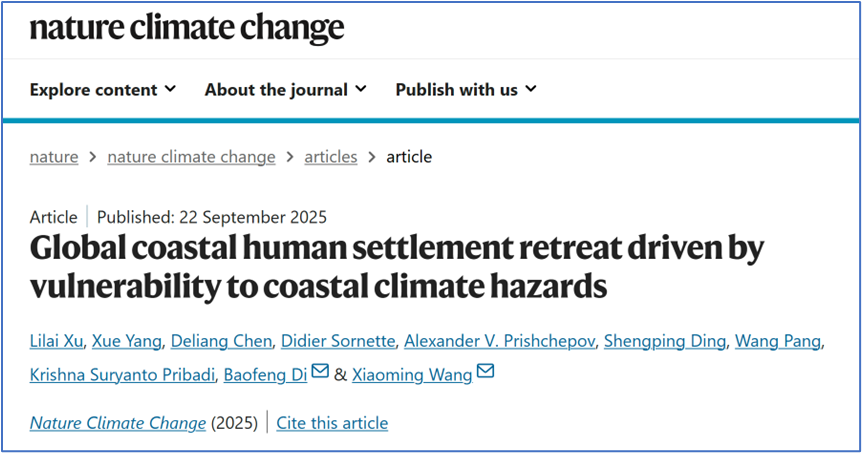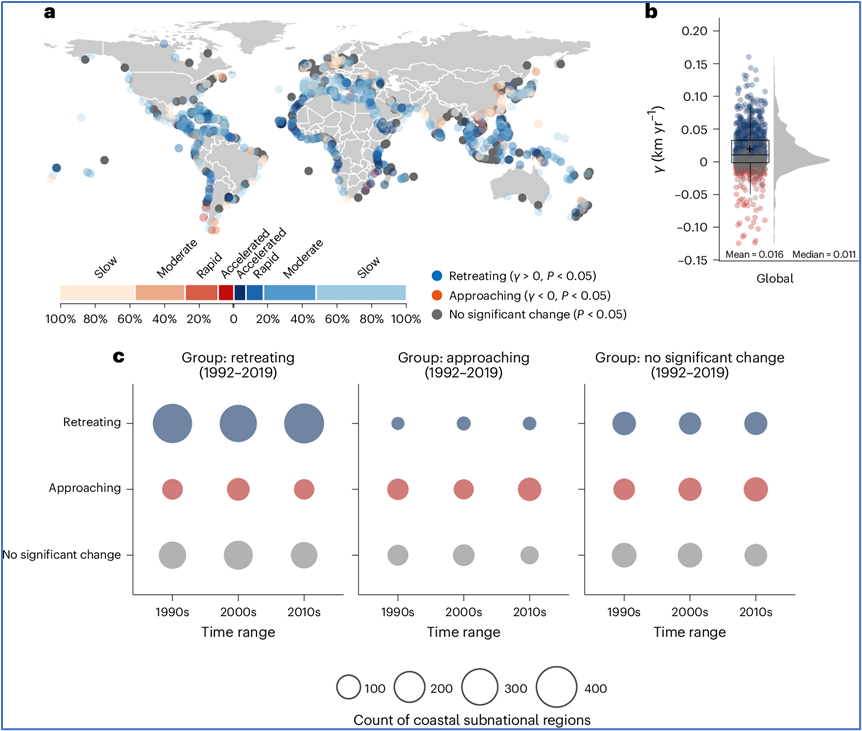Recently, Associate Researcher Xu Lilai and Professor Di Baofeng from IDMR, along with their collaborators, published an article titled "Global coastal human settlement retreat driven by vulnerability to coastal climate hazards" in the top international journal - Nature Climate Change. The study reveals the migration patterns of human settlements in the global coastal zone over nearly 30 years and their relationship with climate vulnerability, and thus provides a scientific basis for coastal climate adaptation policy-making. Dr Xu Lilai from IDMR is the first author of the article, while Professor Di Baofeng from IDMR and Professor Wang Xiaoming from Monash University in Australia and Northwest Institute of Eco-Environment and Resources, Chinese Academy of Sciences are the corresponding authors. The co-authors include Professor Chen Deliang from Tsinghua University, Professor Didier Sornette from Southern University of Science and Technology, Professor Alexander Prishchepov from the University of Copenhagen, and Professor Krishna Suryanto Pribadi from Bandung Institute of Technology.

Accordingly, aside from coastal settlements, which are important spatial entities for human activity and settlement, located in the "water-land" ecobchzone, with high population density, dense infrastructure and strong socio-economic activities, they are high-risk areas affected by extreme disaster events caused by climate change. The spatio-temporal changes in coastal settlements reflect an important adaptive behavior in response to climate risks. However, the current global-scale migration patterns for coastal settlements, influencing factors and climate risk response gaps are unclear, which limits the formulation and assessment of coastal climate resilience development policies.

This study, therefore, by integrating multi-source data, including night-time lights, built-up footprint, historical disasters, and socio-economic data, calculated the average distance between human settlements and coastlines in 1,071 coastal provincial administrative units worldwide from 1992 to 2019. The results revealed the global patterns of coastal settlement migration and their relationship with climate vulnerability under different development levels. The study found that about 56% of the world's coastal settlements showed a significant trend of moving inland, while about 16% moved along the coastline, and no significant changes were observed in 28% of the regions. The migration pattern was not significantly associated with historical disasters but with climate vulnerability, whereby human settlements moving inland showed higher overall climate vulnerability, and the migration rate was faster in areas with lower levels of disaster protection and weaker social resilience. Moreso, the study found that when considering coastal settlement migration patterns, disaster preparedness levels and social resilience, about 46% of the world's underdeveloped regions, mainly in Africa and Asia, show the most significant climate risk response gaps and are key areas for future climate change risks. The findings can provide important references for tracking global coastal climate adaptation progress, assessing sustainable development goals, and formulating climate resilience development policies.
The study was supported by the National Key Research and Development Program, the National Natural Science Foundation of China, and the Sichuan International Science and Technology Innovation Cooperation Program.
It is accessible via a lins: https://www.nature.com/articles/s41558-025-02435-6














